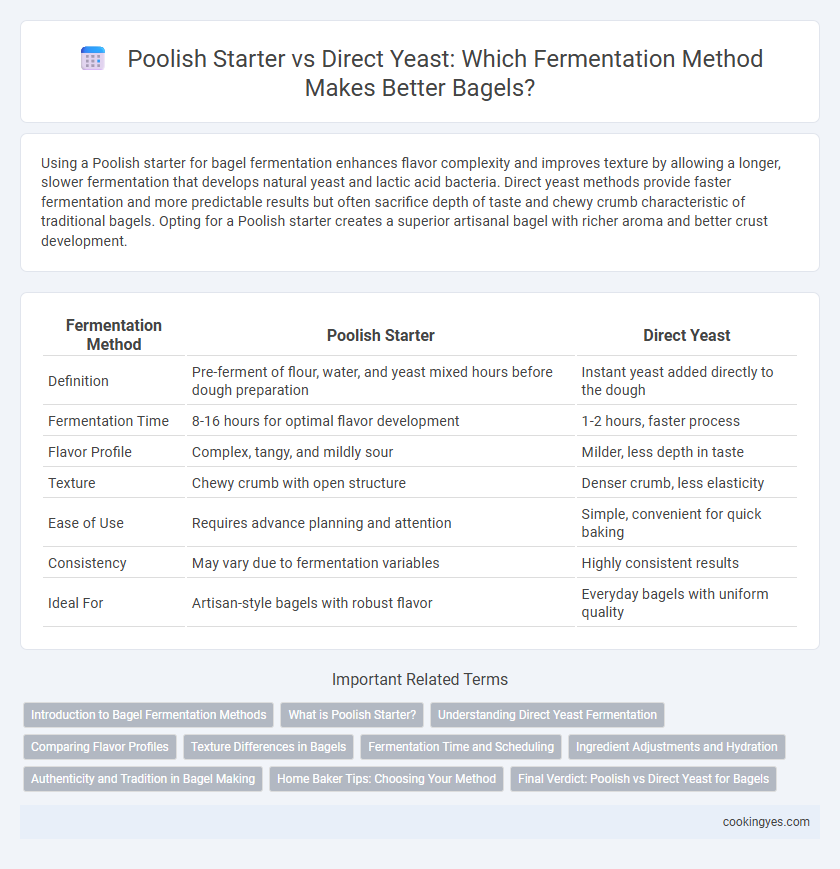Using a Poolish starter for bagel fermentation enhances flavor complexity and improves texture by allowing a longer, slower fermentation that develops natural yeast and lactic acid bacteria. Direct yeast methods provide faster fermentation and more predictable results but often sacrifice depth of taste and chewy crumb characteristic of traditional bagels. Opting for a Poolish starter creates a superior artisanal bagel with richer aroma and better crust development.
Table of Comparison
| Fermentation Method | Poolish Starter | Direct Yeast |
|---|---|---|
| Definition | Pre-ferment of flour, water, and yeast mixed hours before dough preparation | Instant yeast added directly to the dough |
| Fermentation Time | 8-16 hours for optimal flavor development | 1-2 hours, faster process |
| Flavor Profile | Complex, tangy, and mildly sour | Milder, less depth in taste |
| Texture | Chewy crumb with open structure | Denser crumb, less elasticity |
| Ease of Use | Requires advance planning and attention | Simple, convenient for quick baking |
| Consistency | May vary due to fermentation variables | Highly consistent results |
| Ideal For | Artisan-style bagels with robust flavor | Everyday bagels with uniform quality |
Introduction to Bagel Fermentation Methods
Poolish starter fermentation for bagels involves a pre-fermentation step using equal parts flour and water combined with a small amount of yeast, enhancing flavor complexity and crumb texture through extended fermentation. Direct yeast fermentation skips this step by mixing yeast directly into the dough, producing a quicker rise but often less depth of flavor. Choosing between poolish starter and direct yeast impacts the bagel's chewiness, aromatic profile, and crust development.
What is Poolish Starter?
Poolish starter is a type of pre-ferment made from equal parts flour and water with a small amount of yeast, used to enhance flavor and texture in bagel dough. This fermentation process allows natural sugars to develop, resulting in a chewier crust and more complex taste compared to direct yeast methods, which mix all ingredients at once. Poolish requires longer fermentation time, promoting better yeast activity and improved gluten structure essential for authentic bagel quality.
Understanding Direct Yeast Fermentation
Direct yeast fermentation in bagel making involves mixing yeast directly with flour and water, accelerating the fermentation process compared to Poolish starters. This method produces a denser crumb and a slightly less complex flavor profile due to shorter fermentation times. Bakers favor direct yeast fermentation for consistent results and faster production, especially in commercial settings where time efficiency is crucial.
Comparing Flavor Profiles
Poolish starter fermentation produces bagels with a complex, tangy flavor and a slightly chewy texture due to extended fermentation and natural yeast activity. Direct yeast fermentation yields a more straightforward, mildly sweet taste with a denser crumb, as the process is faster and relies on commercial yeast alone. The subtle acidity and depth achieved through poolish enhance the overall flavor complexity, making it preferred for artisanal bagels.
Texture Differences in Bagels
Using a Poolish starter in bagel fermentation enhances gluten development, resulting in a chewier and more complex crumb texture compared to direct yeast methods. The extended fermentation time with Poolish promotes organic acid production, which tightens the crumb and improves crust elasticity. Direct yeast fermentation produces denser bagels with a less pronounced chew due to shorter fermentation and minimal enzymatic activity.
Fermentation Time and Scheduling
Poolish starter requires an extended fermentation time, typically 12 to 16 hours, which allows for enhanced flavor development and a more complex crumb structure in bagels. Direct yeast fermentation is faster, usually completed within 1 to 2 hours, making it ideal for tight production schedules but resulting in a simpler flavor profile. Scheduling with poolish demands overnight preparation, while direct yeast facilitates same-day baking, influencing operational planning in bagel production.
Ingredient Adjustments and Hydration
Poolish starter requires adjusting flour and water ratios to maintain desired hydration levels, typically resulting in a more hydrated dough compared to direct yeast methods. Using poolish also alters the timing and fermentation process, often requiring less yeast and longer fermentation to develop flavor and structure. In contrast, direct yeast fermentation involves simpler ingredient adjustments with more straightforward hydration control, leading to a denser, chewier bagel texture.
Authenticity and Tradition in Bagel Making
Using a Poolish starter in bagel fermentation enhances authenticity by replicating traditional Eastern European methods, allowing natural yeast and bacteria to develop complex flavors and chewy textures emblematic of classic bagels. Direct yeast fermentation, though faster, often sacrifices depth and heritage, producing less nuanced taste and a softer crumb inconsistent with time-honored recipes. Authentic bagel makers prioritize Poolish starters to maintain the cultural integrity and artisanal quality intrinsic to genuine New York-style bagels.
Home Baker Tips: Choosing Your Method
Home bakers choosing between poolish starter and direct yeast for bagel fermentation should consider flavor complexity and fermentation time. Poolish starter, a pre-ferment made from equal parts flour and water with a small amount of yeast, enhances flavor depth and improves dough texture by allowing extended fermentation. Direct yeast offers a quicker rise but may result in less developed taste and denser crumb, making poolish ideal for those prioritizing artisanal quality without professional equipment.
Final Verdict: Poolish vs Direct Yeast for Bagels
Poolish starter enhances bagel fermentation by improving flavor complexity and crust texture through extended fermentation, while direct yeast offers faster proofing times but less depth in taste. Using poolish results in a chewier crumb and more aromatic profile, ideal for artisanal bagels seeking traditional qualities. The final verdict favors poolish for premium bagels despite longer preparation, whereas direct yeast suits quicker production without sacrificing basic quality.
Poolish starter vs Direct yeast for bagel fermentation Infographic

 cookingyes.com
cookingyes.com